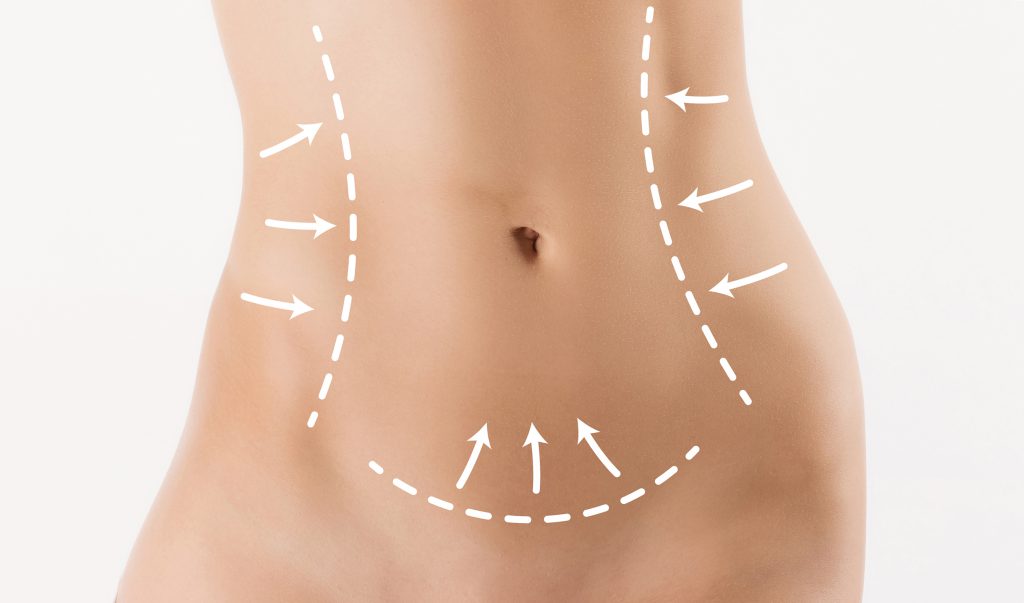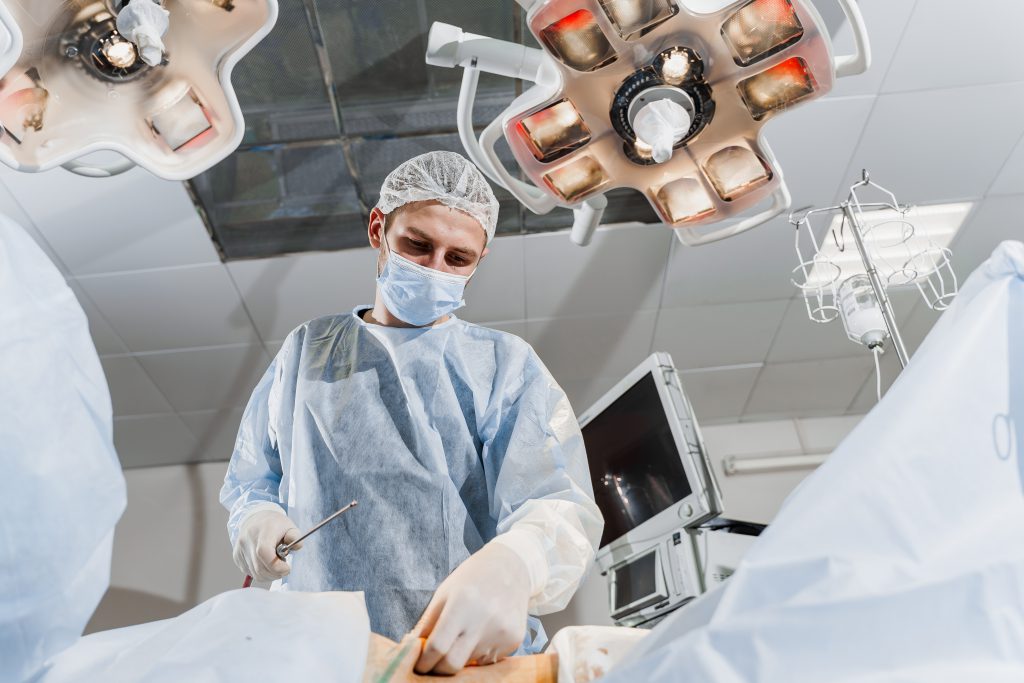Abdominoplasty surgeries performed by Dr. Sera and excision of contours.
Tummy tuck surgery is one of the cosmetic procedures that aims to remove excess skin and strengthen the abdominal muscles, when there are large amounts of excess skin in a group of people.
The problem of sagging weight is defined as an increase in skin and fat in the abdominal area or around the navel and may be accompanied by weakness in the abdominal muscles.
As a result of the recent spread of sagging abdomen, which affects self-confidence and a person’s health, we resort in these cases to tummy tucks and contouring, which is one of the most effective methods.


There are several reasons for the presence of sagging abdomen:
Changes in the patient’s weight.
• Recurrent pregnancy.
• Cesarean section deliveries.
• Abdominal surgeries.
• The presence of a large hernia in the umbilical region.
• Aging.
• The nature of the body.
• Recurrent pregnancy.
• Cesarean section deliveries.
• Abdominal surgeries.
• The presence of a large hernia in the umbilical region.
• Aging.
• The nature of the body.
There are two types of tummy tuck operations:
The two types differ in how they are performed and how much skin is removed:
• Full tummy tuck operation :-
During this operation, excess fat and skin in the abdominal area below the navel are removed, the weak muscles of the abdominal wall are tightened, and the navel’s location is changed.
• Mini tummy tuck operation :-
It is considered a simpler operation than the full abdominoplasty, because it aims to remove the skin below the navel area without changing the location of the navel. It may be accompanied by tightening the abdominal muscles in the lower area of the abdomen only.
• Full tummy tuck operation :-
During this operation, excess fat and skin in the abdominal area below the navel are removed, the weak muscles of the abdominal wall are tightened, and the navel’s location is changed.
• Mini tummy tuck operation :-
It is considered a simpler operation than the full abdominoplasty, because it aims to remove the skin below the navel area without changing the location of the navel. It may be accompanied by tightening the abdominal muscles in the lower area of the abdomen only.

There are some cases for which a tummy tuck is most suitable, which are:
• Women after repeated pregnancies and deliveries.
• Obese patients.
• Those who suffer from mild localized obesity in the abdominal area who do not respond to diets.
There is a recovery period for tummy tuck surgery:
You can be discharged from the hospital within several hours of the operation, but the recovery period from the tummy tuck operation may extend for 1-2 months, during which a complete recovery from the operation is made and the result is clearly visible, as the pain disappears, the swelling decreases, and the fluid accumulates in the place of the operation gradually. In order to speed up the healing process; the doctor’s instructions should be carried out after the operation.
The difference between liposuction and tummy tuck:
Liposuction is based on getting rid of excess fats from places where fat cells accumulate in the body in a chronic way, which is difficult to get rid of using traditional weight loss methods.
During liposuction, a small hole is made in the skin layers and a thin tube connected to a liposuction device is inserted.
As for the abdominoplasty operation, the excess skin in the anterior abdominal wall is cut and a flap is stretched from the upper piece of the abdominal wall and attached to the remaining piece above the pubic region through surgical sutures, then a place for the navel is made in the new abdominal wall if necessary.
Usually, the two operations are combined, as liposuction alone is not sufficient to give the abdomen a flat shape free of sagging, so the doctor resorts to combining it with tummy tuck surgery to obtain the desired results.
As for umbilical hernia surgery:
• Obese patients.
• Those who suffer from mild localized obesity in the abdominal area who do not respond to diets.
There is a recovery period for tummy tuck surgery:
You can be discharged from the hospital within several hours of the operation, but the recovery period from the tummy tuck operation may extend for 1-2 months, during which a complete recovery from the operation is made and the result is clearly visible, as the pain disappears, the swelling decreases, and the fluid accumulates in the place of the operation gradually. In order to speed up the healing process; the doctor’s instructions should be carried out after the operation.
The difference between liposuction and tummy tuck:
Liposuction is based on getting rid of excess fats from places where fat cells accumulate in the body in a chronic way, which is difficult to get rid of using traditional weight loss methods.
During liposuction, a small hole is made in the skin layers and a thin tube connected to a liposuction device is inserted.
As for the abdominoplasty operation, the excess skin in the anterior abdominal wall is cut and a flap is stretched from the upper piece of the abdominal wall and attached to the remaining piece above the pubic region through surgical sutures, then a place for the navel is made in the new abdominal wall if necessary.
Usually, the two operations are combined, as liposuction alone is not sufficient to give the abdomen a flat shape free of sagging, so the doctor resorts to combining it with tummy tuck surgery to obtain the desired results.
As for umbilical hernia surgery:
The umbilical hernia:
It occurs in the vicinity of the umbilicus and many children suffer from it as a result of the lack of complete closure of the blood vessels in the umbilical cord.
In many babies, the navel may protrude outward when crying. This is a classic sign of an umbilical hernia, a very common but not serious condition in most cases.
And the treatment of abdominal wall hernias through an operation that is performed by the method of open surgery or medical laparoscopy.

As for the symptoms of an umbilical hernia:
• A small bulge, or soft bump, near the navel. The bump is usually between one and five centimeters in diameter.
• Watching the umbilical hernia in infants while crying or exerting only, and the bump may disappear when the child calms down, or when he lies on his back.
• A feeling of discomfort in the abdomen in adults.
• Long-term pain or discomfort.
• Pain or discomfort that interferes with daily activities.
• Pain or discomfort worsens over time.
• Increase the size of the hernia rapidly.
• Severe pain in the abdomen and vomiting.
• Hernias that press on nerves and cause irritation and numbness.
• Traction of tissues, such as: the intestines in the abdominal wall, which may lead to cutting off blood flow to them if left untreated.
There are several steps to this surgery:
• Making a surgical incision to open the skin.
• Gently pushing the hernia back into the abdomen, tying it down, or removing it.
• Close and strengthen the weak area of muscle with stitches, or by adding elastic mesh for more support in larger hernias, which will help prevent the hernia from recurring.
There is a recovery period and it takes from 3-6 weeks after the abdominal hernia and takes from one to two weeks to be able to return to his daily activities.
• Watching the umbilical hernia in infants while crying or exerting only, and the bump may disappear when the child calms down, or when he lies on his back.
• A feeling of discomfort in the abdomen in adults.
• Long-term pain or discomfort.
• Pain or discomfort that interferes with daily activities.
• Pain or discomfort worsens over time.
• Increase the size of the hernia rapidly.
• Severe pain in the abdomen and vomiting.
• Hernias that press on nerves and cause irritation and numbness.
• Traction of tissues, such as: the intestines in the abdominal wall, which may lead to cutting off blood flow to them if left untreated.
There are several steps to this surgery:
• Making a surgical incision to open the skin.
• Gently pushing the hernia back into the abdomen, tying it down, or removing it.
• Close and strengthen the weak area of muscle with stitches, or by adding elastic mesh for more support in larger hernias, which will help prevent the hernia from recurring.
There is a recovery period and it takes from 3-6 weeks after the abdominal hernia and takes from one to two weeks to be able to return to his daily activities.
